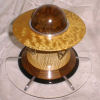and by no means comprehensive
in a nutshell: the greater the angular difference between bevels the less honing time needed, or the greater the jump in grits feasible.
so, if you wish to hone a flat bevel with no microbevel you will spend lots of time honing at the finer grits, just polishing the bevel. it looks great but puts unnecessary wear on your stones and your elbows.
if you start with a really low primary bevel you can probably jump straight to your finishing stone. kind of crude looking and perhaps a bit fragile.
use a really high microbevel and the time on the finish stone will be minimized but the chisel may not perform well for paring despite being sharp.






 Reply With Quote
Reply With Quote









